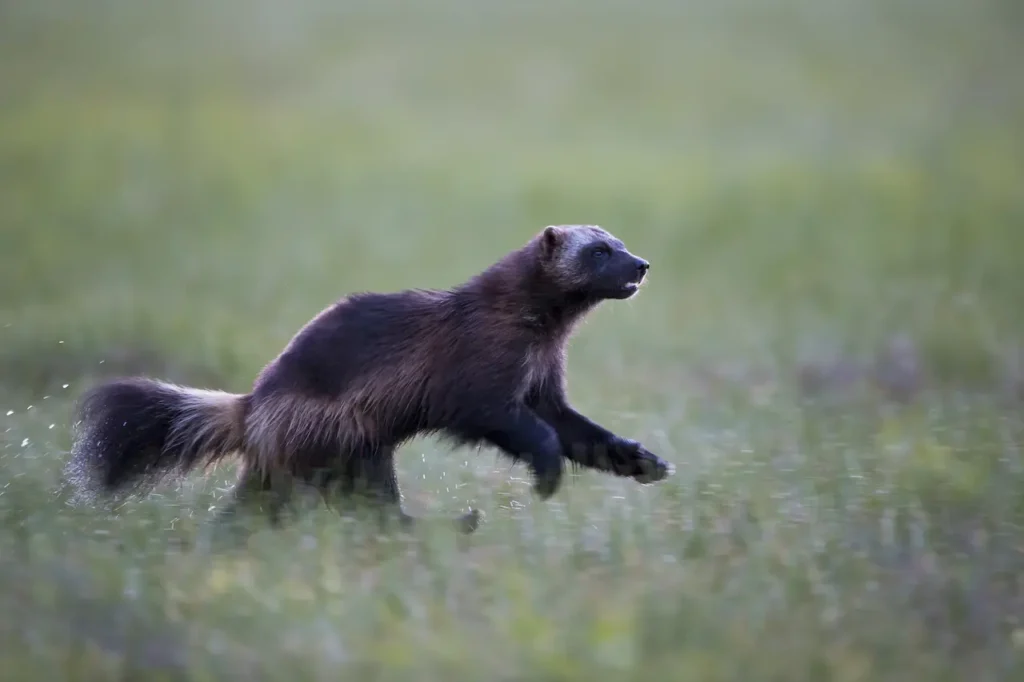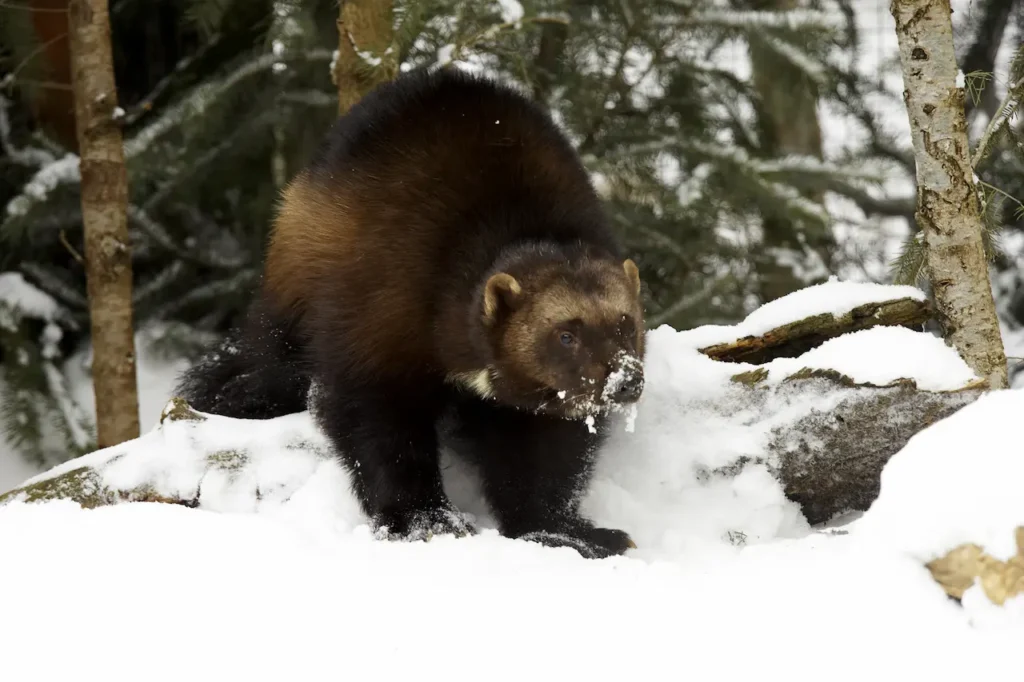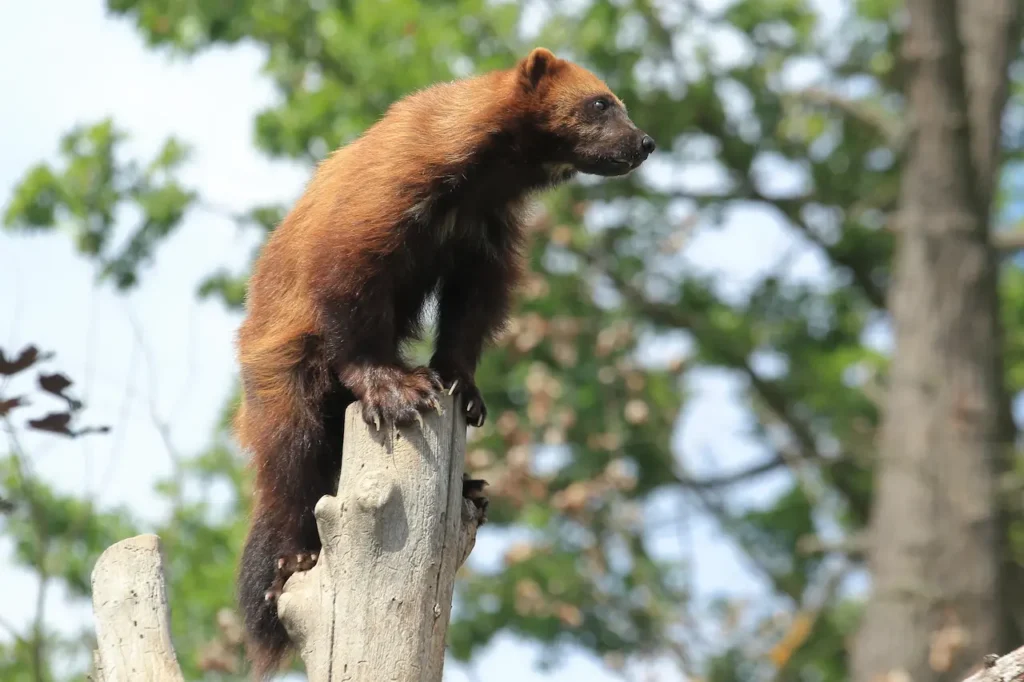What Eats A Wolverine?
Categories
- Accipitridae (1)
- Acrididae (1)
- Algae (2)
- Alligatoridae (1)
- Amoebidae (1)
- Amphibians (3)
- Anatidae (1)
- Anguillidae (1)
- Arachnids (2)
- Bears (2)
- Big Cats (3)
- Birds (13)
- Bovidae (5)
- Bufonidae (1)
- Camelids (1)
- Cameras (1)
- Canines (13)
- Caridea (1)
- Carnivora (10)
- Castoridae (1)
- Cats (5)
- Cebidae (1)
- Cephalopod (1)
- Cervidae (2)
- Cetacean (1)
- Chondrichthyes (1)
- Crocodilia (2)
- Crustaceans (4)
- Culicidae (1)
- Cyaneidae (1)
- Dasypodidae (1)
- Dasyurids (1)
- Deer (1)
- Delphinidae (1)
- Desktop (1)
- Didelphidae (1)
- Dinosaurs (1)
- Dogs (13)
- Dolphins (2)
- Echinoderms (1)
- Education (10)
- Elephantidae (1)
- Equine (1)
- Erethizontidae (1)
- Erinaceidae (1)
- Farming (1)
- Felidae (5)
- Fish (5)
- Food Chain (31)
- Food Web (2)
- Formicidae (1)
- Frugivore (1)
- Gaming (1)
- Gastropods (1)
- Giraffids (1)
- Great Apes (2)
- Health Conditions (3)
- Herbivore (4)
- Hi-Fi (1)
- Hippopotamidae (1)
- Hominidae (1)
- Insects (10)
- Invertebrates (2)
- Keyboards (1)
- Laptops (1)
- Leporidae (1)
- Mammals (23)
- Marsupials (4)
- Mephitidae (1)
- Microchiroptera (1)
- Mollusks (2)
- Mongoose (1)
- Muridae (1)
- Nocturnal Animals (1)
- Odobenidae (1)
- Omnivore (2)
- Phasianidae (1)
- Phocidae (1)
- Plankton (1)
- Plants (2)
- Primate (1)
- Ranidae (1)
- Reptiles (7)
- Rhinocerotidae (1)
- Rodents (5)
- Salamandridae (1)
- Scarabaeidae (1)
- Sciuridae (2)
- Sharks (1)
- Shellfish (1)
- Sound (1)
- Spheniscidae (1)
- Suidae (1)
- Superfamily Papilionoidea (1)
- Theraphosidae (1)
- What Eats (5)
A fierce and tenacious animal, wolverines are more commonly known as the ‘glutton’ of the animal kingdom and are found in the more northern regions of North America, Europe, and Asia.
Their stocky, carnivorous bodies weigh between 20 and 55 pounds, and these weasels belong to their family for their strength, sharp claws, and powerful jaws. With their build, they survive in the extremely harsh snow and mountainous landscapes, hunting or scavenging.
Wintering wolverines are solitary and roam large areas of habitat in search of food. For their size, they are incredibly brave and will actually challenge predators multiple of their size to protect a meal or territory.
Wolverines eat a variety of things – small mammals, birds, and when they can find them, the large carcasses of moose or deer. Their jaws are strong enough to crush bones and feed on almost anything, including frozen meat.
Table of Contents
ToggleWhat Eats A Wolverine?
This fierce animal, as it is, does have its share of threats in the wild. Although wolverines defend themselves well, they nonetheless are food for a few predators. Six species are explored that can threaten these fearless creatures after.
Wolves
In Wolverine’s shared habitat, one of the biggest threats is wolves. Pack animals hunt in groups and have an advantage over the solitary wolverine.
Wolves largely prey on larger animals such as elk and deer, but they won’t let a wolverine walk away with all the food if a wolf views it as competition. Being opportunistic feeders, wolverines frequently scavenge wolves’ kills, and sometimes this gets them killed.
A fully grown wolverine would be able to kill an adult wolf. The Wolverine is tenacious and has sharp claws. But wolves attack as they are a pack, which quickly flips the odds in their favor.
As a coordinated strategy, PACK WOLVES ARE difficult to stop if one Wolverine is alone up against several wolves.
Wolverines’ most dangerous adversaries are usually themselves and wolves because their conflict is over food resources, and wolves have the ability to work together.
Bears
Wolverines are formidable predators, but bears, especially grizzlies and brown bears, are more formidable, and if they come across a wolverine, they will almost certainly kill it.
Wolverines are at a clear disadvantage, as bears are much larger and stronger and possess the ability to easily put a wolverine down with one shove of their giant, powerful paws.
The big conflict between bears and wolverines is over carcasses. Both are scavengers, and often, there is a fight over a fresh kill.
While a wolverine will sometimes try to defend its food from a bear, it doesn’t work out well for the wolverine. But although wolverines are brave and aggressive, they are no match for a bear’s size and brute strength.
A wolverine, at several hundred pounds, could be overpowered and eaten by a bear if that’s what it came to. But otherwise, they usually take care around bears and will avoid direct confrontation, using their speed and their stealth.
Mountain Lions (Cougars)
Agile, powerful predators, mountain l, ions cougars or pumas are common in North America, where wolverines also live.
Cougars are solitary hunters and are known to eat deer, small mammals, and even wolverine. The wolverines have little warning, given that mountain lions like to ambush stealthily.
Cougars are good climbers and ambush wolverines from trees or high places; they cao. Wolverines are strong fighters; they are not as fast or quiet fighters as Cougars.
When a wolverine encounters a mountain lion, that confrontation generally ends with a beaten wolverine running or being overpowered by the cat’s superior speed, strength, and claws.
Although wolverines are quite fierce, they tend to be ambushed by mountain lions who pick young, inexperienced, or weakened wolverines upon which to prey.
Golden Eagles
Although the wolverine may seem no match for an eagle, it turns out the golden eagle has been known to take wolverines in its talons, particularly smaller or younger ones.
These are large raptors with great speed, powerful talons, and excellent sight that can be used in spotting prey from above and going in for an attack.
A wolverine doesn’t stand a chance against a golden eagle; not only can an eagle swoop down at speeds, but it can also strike and immobilize the unlucky wolverine before it knows what hit it.
Golden eagles typically take wolverines when they are vulnerable—they are young or distracted while foraging for food. The risk is always there, and adult wolverines can provide the solitary eagle with a very strong defense and defend themselves against eagle attacks.
Golden eagles are a dangerous predator, or at the least not the most common threat to wolverines, but their sheer aerial advantage makes them dangerous, and if the circumstances allow, the eagle can overwhelm wolverines.
Lynxes
The boreal forests and mountainous regions of northern Europe and Asia are habitats shared by wolverines and the Eurasian lyne. Closely related to tigers, these medium-sized cats are excellent hunters with good agility and, sharp claws, and powerful bites.
Despite the fact that wolverines and lynxes are usually quite different territorial animals, they can find themselves in vicious fights over food or food areas.
With its stealth and quick reflexes, a lynx can catch a wolverine by surprise. Although wolverines are extremely strong fighters and have a great defense, lynxes are capable leapers, and one swift strike with their paw could doom wolverines.
As a result, adult lynxes generally choose not to engage in direct confrontations with adult wolverines, but they do spare no opportunity to attack a young, naive, or weak wolverine.
Humans
Humans are no natural predators, yet they present a great danger to wolverines. Overall time, the wolverine has been hunted for its fur, which is prized for being hardy and keeping one warm.
Deforestation, mining, and urban development by humans entering the wolverine’s native habitat are also destroying its ecosystems and making it more challenging for them to survive.
They have also sometimes been considered a nuisance by hunters and trappers because they eat carrion and destroy traps. As such, humans have hunted wolverines in some places hard for competition and protecting livestock.
Wolverine populations remain at risk, however, and human activities continue to pose one of the biggest threats to their continued existence.
What Does A Wolverine Eat?
Let’s dive deeper into what a wolverine eats and look at six different types of prey and types of food on their varied diet.
Wolves (Canis lupus)
Wolverines rank as one of the most imperiled mammals in North America, and wolves are one of the most significant threats. For this reason, these canines are pack hunters, able to work in tandem to bring down larger prey than twice their size.
Wolverines are normally solitary and stand up well to one one-on-one confrontations but they are no match for a wolf pack. Wolverines have no allies to help fight off a pack of wolves, who can very effectively hunt as a pack, surrounding and outnumbering a wolverine until it can’t escape or defend itself.
In parts of North America, Europe, and Asia, where they hunt prey closely resembling each other — deer, moose, and smaller mammals — wolverines and wolves inhabit overlapping habitats. They often conflict directly for food.
Although wolverines are opportunistic scavengers, they often stumble across wolf carcasses, left behind of course. When a wolverine tries to steal a carcass, however, it takes on an entire pack.
Wolverines stain the snow a yellow color which wolves mistake for wolf scat; wolves consider wolf scat to mean a wolverine is in the area looking for a fight and is easily provoked into fighting with the wolverine, especially if it is near their kill and food.
Bears (Ursidae)
Both black bears (Ursus americanus) and grizzly bears (Ursus arctos) are natural enemies of wolverines. These bigger, more dominant predators range in much the same habitat as a wolverine and will not fail to attack one if it transgresses into their food or space.
Bears are omnivores that are opportunistic feeders and in situations of competition will attack and kill wolverines, although this is not for food.
Carrion is a common point of contention between bears and wolverines. Wolverines are good scavengers and it’s often what attracts them to a place — a bear’s old carcass left for them to pick a fight over.
When a wolverine is pursued over a carcass by a bear, the battle is likely to be deadly. While the wolverine has quite a bad reputation, a bear is just too big and strong and powerful for them.
A wolverine weights normally about 30–50 pounds, while a grizzly bear can get up to 1,000 pounds. In a fight, a wolverine’s strength is nothing compared to a bear’s massive paws and crushing bite.
However, these conflicts more typically occur in late winter or early spring, and they happen when food is at a premium, and when scavengers are actively out looking for that meal.
When you consider that a wolverine stands no chance of overpowering a bear, and a bear could feasibly hunt down a territory harrying wolverine, then it makes the bear a massive threat.
Mountain Lions (Puma concolor)
On one side, mountain lions — also known as cougars or pumas — are another top predator, sharing habitat with wolverines. As stealthy hunters, these big cats have incredible strength, agility, and speed.
In solitary animals (unless breeding) the mountain lion generally stalks its prey, which at times can be small mammals, but most often large ungulates such as deer or elk.
A wolverine might be taken by a mountain lion if it stumbles into its territory or tries to fight him for something to eat.
Mountain lions are also powerful jumpers and surprise their prey when they leap great distances. Because they are much smaller than mountain lions, a wolverine often has scant opportunity to escape after being ambushed.
Not caught off guard a wolverine could quickly endanger a mountain lion with their sharp claws and powerful bite. While wolverines are renowned for their ferocity in the fight, a mountain lion is generally too large and have the tools of the trade to beat them.
Both species are interesting in that while they will scavenge and take the food when there is available, they will come into conflict over resources. The attack could be provoked if a wolverine tries to feed on a mountain lion’s kill.
Although wolverines usually take larger prey and actively avoid mountain lions, if mountain lions move into wolverine territory, they treat them as a threat or potential meal and are thus a significant wolverine predator.
Aquila chrysaetos
Golden eagles are fierce predators of birds and other animals, and are as notorious for their ferocity as their talents when it comes to killing very big animals.
Though denizens of small mammals like rabbits, hares and ground squirrels, raptors do also hunt young or small wolverines. Widespread throughout the Northern Hemisphere, golden eagles live in overlapping wolverine habitat including mountains, tundra and forests.
The powerful talons and keen eyesight of golden eagles makes them a threat to wolverines. These examples are joint birds that assume flying from unbelievable statures to chase their prey.
An opportunistic eagle can pluck a young wolverine from its den, as it is less experienced, an eagle like a targeted it. Adult wolverines, usually too large to make good prey, can also be at risk if they are sick or the victim of parasites.
Golden eagles do not typically attack wolverines — they will attack them, particularly in an open situation where they have the high ground — but do not specifically seek wolverines to hunt.
Its talons can crush and immobilize prey, and a swooping eagle can carry out a fatal strike using them. Though rare predators for full grown wolverines, golden eagles are a danger to the young and less observant members of the species.
Humans (Homo sapiens)
For many years humans have been a major predator of wolverines, both directly and indirectly. Wolverines were hunted in the past, simply because their fur is thick and warm and the sort of thing good for winter clothing.
Recent times have found the hunting regulations to be more stringent than ever before, but some areas allow for controlled hunting and trapping of wolverines – an act that directly threatens their population.
Wolverines are also imperiled by human activities that indirectly affect their habitat. The wolverine is a solitary animal and the threats to its remaining habitat in the North is logging, mining and urban development, all of which destroy and fragment their natural habitat, making it much tougher for them to find food, shelter and mates.
Additionally, risk of vehicle collision, trapping, and illegal poaching is raised by road networks and human encroachment. Human causes of climate change also affect wolverine habitat through changes in snowpack, that snowpack being important for denning.
Humans don’t usually hunt wolverines for food, but they are a top predator that packs a serious wallop. Human beings are a primary threat to the survival of wolverines because they combine direct hunting, loss of habitat and changing of the environment.
Lynx (Lynx canadensis)
Parts of the Canada lynx’s habitat, which also include their habitat with wolverine, can be found in the northern forests of both North America and parts of Eurasia. They are solitary hunters, stalking, running and sharp scratching their way to their prey.
A lynx mainly eats hares, rodents, and other small mammals, but wolverines may become the subject of lynx predation when it comes to disputes over food or territory. The same prey is also often shared between lynx and wolverines, and thus potential for conflict.
A lynx will even attack if a wolverine approaches its kill. But although smaller than some of the other predators that contend with wolverines, a lynx has sharp claws and agility to rip the wolverine up.
Proud and bold, wolverines are vicious, but lynx respond with quick reflexes and excellent climbing skills that give them the advantage of surprise attacks (or the ability to make a swift escape).
The outcome from an actual encounter between a lynx and a wolverine is a direct competition that could go either way.
But the lynx is not considered a predator to wolverines, as lynx are stealthy and good at hunting, and able to prey on young, injured or otherwise susceptible wolverines. These two solitary hunters don’t often interact, but when they do, it can be deadly.
Conclusion
Fierce adaptable omnivores, wolverines eat small mammals, carrion, birds as well as, when necessary, the occasional plant or two. But they are ferocious and are threatened by predators such as wolves, bears, mountain lions, golden eagles, lynx, and people.
Larger or more strategic predators can get the best of wolverines through pack behavior, strength, stealth, or face off in a hostile territorial confrontation. However, wolverines are survivors, flourishing to take what they must in the environments they survive in.



